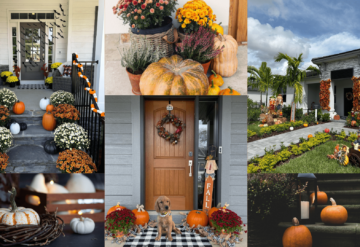Your home’s curb appeal is its first impression to your family, friends, and neighbors. Good landscaping can help maintain an aesthetically pleasing look and feel, and bring you joy everyday. Learn about the landscaping rules that you should never break in this U.S. News article by Devon Thorsby.
Your home’s exterior appearance is important, whether you like to admire your garden from your living room window, host regular backyard barbecues or have a youth soccer team practice out front on the weekends. Planning the right landscaping – purely for aesthetics or utility – is imperative to help you achieve the right look and level of maintenance that works for you.
Homeowners’ use of the front or backyard can vary widely – and include everything from a patio spa or herb garden to a complete outdoor chef’s kitchen for entertaining. Despite the many options you have for making the most of your outdoor space, there are still a few cardinal rules for ensuring your landscaping is a success.
Here are 10 key rules that will help guide you to a flourishing, comfortable yard that suits your needs.
1. Consider the right plants for your climate.
From grass to trees to the bushes lining your walkway, you have choices to make not just about the right aesthetic for your house, but also regarding what plants are best-suited for the part of the country you live in and how they’ll fare outside your home.
Kris Kiser, president and CEO of the Outdoor Power Equipment Institute, stresses the importance of “right plant, right place,” which means taking advantage of local plant species that will flourish where you live and in the right part of a yard, and don’t require too much water in a dry climate or grow too large and choke out other plant life. The type of grass you choose for your lawn based on where you live is just as important, as the wrong species will likely die or require more maintenance than it’s worth.
“There’s hundreds and hundreds of species of turf, so you don’t want to put a lush Kentucky bluegrass in Southern California where it’s water-challenged – you want a Bermuda or a buffalo grass,” Kiser says.
2. Avoid overdeveloping your yard.
Not every homeowner is looking for a secret garden in their backyard – and that’s OK – but it’s best (and more budget-friendly) to size your outdoor living area or patio appropriately to your house.
You may want a pool here, a fire pit farther back and a flower garden with seating off to the side, but you’re likely overextending your yard and your budget, explains Chip Wade, a master carpenter best known for his roles on HGTV shows like “Ellen’s Design Challenge” and “Curb Appeal: The Block,” and a consultant for Liberty Mutual Insurance.
“Keep the action close to the house, and focus more of your budget in one place,” he says. “It will make the overall final product more effective and higher quality.”
Additionally, too much pavement in your yard can cause runoff problems when it rains. Don’t install a backyard pool so large that you’ve removed all space for plants, which can help you avoid basement flooding issues.

3. Plan for the right professional help.
Like with any do-it-yourself project, be aware of your limits and know what home improvements require a licensed professional to ensure the work is done properly. Expect to book work from a skilled contractor at least a few months in advance during spring and summer. Kris Holland, owner of Black River Landscape Management, based in Randolph, New Jersey, says that by early March, his company’s calendar is already full through part of May.
“If you can call somebody in March and they can say, ‘Hey, we can be there on your property tomorrow,’ then maybe you have to worry why they have the ability to do that,” Holland says.
Read the Full Article HERE.




